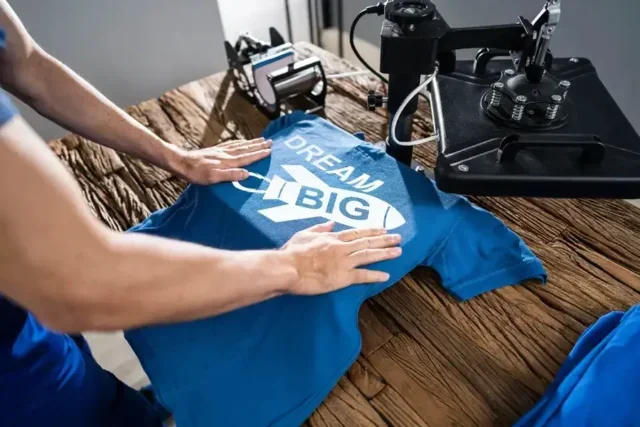AFFILIATE MARKETING
11 Easy Online Business Ideas to Make Money From Home in 2024

There are a number of ways to cash in from affiliate marketing, from posting on social media to writing blog posts. One of the best things about affiliate marketing is that it doesn’t require any start-up costs, making it one of the most affordable ways to generate passive income.
2. Make an online course
- Pros: Easy to set up
- Cons: Need to market it yourself
- Earning potential: $100 to $1,000 a month (as a beginner)
If you’ve got specific knowledge or a skill you think would benefit others, why not make and sell an online course? This is especially true if you’re clued up on new and emerging technologies, as spiking demand for online AI training courses shows.
Selling a course is a cost-effective and scalable way to make a steady income while sharing content you’re passionate about. It’s super easy to get started as well with web builder software like Squarespace and Hostinger.
However, there are some drawbacks to monetizing your knowledge. Just like with affiliate marketing, it is easier to make money with an established audience, so if you don’t have a large follower base, or aren’t prepared to market your course, this may not be the best business idea for you.
3. Dropshipping
- Pros: Requires no start-up inventory
- Cons: Its competetive
- Earning potential: $1,000 to $3,000 in the first year
You’ve probably seen enough YouTube ads by now to know what drop shipping is. But if not, dropshipping is a low-risk business model that lets you sell products to customers without incurring wholesale running costs. Unlike with brick-and-mortar and traditional ecommerce, you don’t have to purchase a product unless you’ve already made a sale, reducing financial risks associated with surplus stock.
Dropshipping is a great option for entrepreneurial spirits with little funds available to invest in inventory. However, the world of dropshipping is extremely competitive, and profit margins are a lot lower than with traditional retail.
4. Write a blog
- Pros: Allows for creative freedom
- Cons: Can take time to build an audience
- Earning potential: $70 to $100 a month (as a beginner)
If you’re a budding wordsmith, or are simply passionate about a certain subject, writing and monetizing a blog could be a good way to earn money on the side. After you’ve carved out your niche and put pen to paper, you’ll need to build a loyal online audience. Once you’ve amassed a decent amount of followers, you’re able to monetize your blog across various channels, including through sponsored posts, product sales, or third-party ads.
The great thing about blogging is you have the freedom to write about anything you care about. It’s also a natural way to foster and connect with an online community of like-minded people.
5. Sell goods online
- Pros: Can set own profit margins
- Cons: Requires start-up inventory
- Earning potential: Up to $10,000 per month
If you’re crafty, or have got an eye for second-hand goods, selling items online can be a decent money-maker. Selling products of your choice allows you to set your own profit margins, and market them to your liking. Lots of ecommerce platforms like Etsy, eBay, and Depop let you retail goods for free too, but they do charge a fraction of each sale.
Selling goods online does require start-up investments though, specifically when it comes to purchasing materials and stock. This makes retailing goods unsuitable to individuals looking to get started for free. Alternatively, you could set up your own site using one of the best ecommerce website builders, which gives you full control of your startup’s finances.
6. Start a print-on-demand business
- Pros: Minimal start-up costs
- Cons: Low margins
- Earning potential: Around $1,500 per month (as a beginner)
Print-on-demand (PoD) is an order fulfillment method where business owners print designs on products like clothing, accessories, and decor using third-party suppliers. Like dropshipping, you don’t need to purchase the stock until the order is received, eliminating the need for costly inventory management. It’s important to research market trends before launching a PoD business, however, as some niches – like sustainable fashion and athleisure – are more lucrative than others.
 Because the design and printing process are handled by third-party suppliers, all you need to do is market your service and manage orders. Like most business ventures on this list, a high-performing site will be necessary to carry out these steps.
Because the design and printing process are handled by third-party suppliers, all you need to do is market your service and manage orders. Like most business ventures on this list, a high-performing site will be necessary to carry out these steps.
7. Sell an online service
- Pros: Can utilize existing talents
- Cons: Hard to build a client base
- Earning potential: Anywhere from $15 to $100 an hour (as a beginner)
You don’t need to sell something tangible to run a successful business. Selling a service like consulting, life coaching or personal training is a great way to profit from existing skills and experience.
This business idea might be appealing to those who already work for a service provider for their 9-5, but are looking to subsidize their income by going freelance in their spare time. However, if you’re experienced enough, are willing to work hard to build a roster of clients, and receive a decent amount of positive testimonials, there’s ample potential to turn this business into a full-time gig.
Don’t have a big marketing budget? Leveraging free-cost marketing channels and networking in your industry are effective ways to spread the word cheaply, according to author and certified speaking coach Kevin Williams.
8. Create and sell NFTs
- Pros: Allows you to profit from pre-existing content
- Cons: Requires technical knowledge
- Earning potential: Anywhere from $200 to $1 million
Another creative way to make money online in 2024 is by making, and selling an original non-fungible token (NFT). While the hype around NFTs has dyed down a little since the technology broke into the mainstream in 2021, they can still be a decent money-maker for those with some spare time and the right technical know-how.
Anyone can make an NFT, but to avoid copyright infringement it’s best to make one from an original asset. However, even if this isn’t possible, you can still generate a decent income from trading NFTs based on trends and popularity.
9. Create a YouTube channel
- Pros: Good way to monetize your passion
- Cons: Time and energy-intensive
- Earning potential: $18 per 1,000 views
If you’ve always wanted to try your hand at vlogging or video editing, monetizing a YouTube channel is a good way to earn massive income and explore your passions at the same time. While it takes work to build a following, once you reach 1,000 subscribers you can launch YouTube ads on your channel, and make up to $0.5 to $2.5 per 1000 views with AdSence.

 Creating a successful YouTube channel isn’t light work though. It can take years before a YouTube channel becomes profitable, so to make real profits on this platform you need to be willing to invest a decent amount of time and effort.
Creating a successful YouTube channel isn’t light work though. It can take years before a YouTube channel becomes profitable, so to make real profits on this platform you need to be willing to invest a decent amount of time and effort.
10. Make a custom GPT
- Pros: Quick and easy to
- Cons: Requires a paid ChatGPT plan
- Earning potential: Up to $1000 a month
With the GPT store opening earlier this year, ChatGPT Premium and Enterprise users are now able to profit from their own custom GPTs. custom GPTs are customizable versions of ChatGPT that are tailored to a specific niche. From Christmas Card Maker’s to Simionizers, the limit really is your image, but as a general rule of thumb, the most successful GPTs will serve a unique use case and will be trained on richer data than similar competitors.
If you’re subscribed to ChatGPT Plus or Enterprise, creating a custom GPT couldn’t be easier too. All you need to do is name your GPT, add instructions and examples to the builder’s drop-down menu, test it, and you’re ready to go live.
For more detailed instructions, learn how to make a GPT that sells in 10 simple steps here.
11. Create an eBook with ChatGPT
- Pros: No start-up costs
- Cons: Very competitive field
- Earning potential: Up to $2500 a week
You don’t need to be a trained author to write an eBook that sells; all you need is ChatGPT and some well-crafted prompts.
AI chatbots are content-creation machines, so it’s unsurprising so many people have begun using them to earn passively in 2024. The creation process is relatively straightforward too; all you need to do is come up with a niche or original idea – this could range from a mystery crime novel to a non-fiction book about botany – come up with a basic book structure (you can use ChatGPT for this too) and then write the book paragraph by paragraphs by feeding ChatGPT descriptive promotes.
After the book is complete, you can sell it directly through Amazon’s Kindle Direct Publishing (KDP), and earn up to 70% from each book sale.
What Do I Need to Start an Online Business?
The first port-of-call for budding entrepreneurs is creating a developed, yet realistic business plan. A business plan helps crystalize your thoughts into clear, actionable steps. Not only is the document critical when you’re taking your tentative first steps, but it’s also a useful tool for reaching important milestones and showing your concept off to investors and lenders.
Another prerequisite for a successful online business is a website. Whether you’re selling goods online or just looking to boost your reach, building a website will improve your business’s credibility and establish your status as an online competitor. Setting up a site doesn’t need to be an arduous task, either. There are tons of website builders that can help you build a professional site quickly and easily, each with their own specialisms and strengths.
Wix performed best in our independent web builder research, thanks to its generous free plan, excellent UX, and dynamic toolkit, while Squarespace edges out the competitor when it comes to design. See how our favorites weigh up side by side in our comparison table below.
Can I Start an Online Business with No Money?
Sure, heaps of capital make it easier to launch a business from the ground up. But this doesn’t mean there are no viable ways to start businesses for free.
If you’ve got a solid idea that requires financial backing, applying for small business loans and grants are great ways to sew seeds that could eventually flourish into a successful, lucrative business. Whether you need to cover operational expenses, invest in inventory, or launch a marketing campaign to get your business seen, financing can help launch a business forward while affording business owners peace of mind.
The US Small Business Administration (SBA) website is home to a variety of lending options including 7 (a) loans – its primary form of small business financial assistance, 504 loans, and microloans. The agency also provides a range of targeted small-business grants, targeted at research and learning institutions and community organizations.
You don’t need to access financing to get ahead, though. There are loads of business ideas to pursue that don’t require funding, including course-building, dropshipping, and selling goods through free sites like Etsy and Amazon. You don’t need to fork out on a pricey website builder to establish your online presence either.
Major names like Wix, GoDaddy, and Squarespace offer solid free plans. However, most free plans lack basic features like custom URLs and ecommerce functionality, so if these are must-haves for you, you’d be better off investing in a paid builder instead. Check out our guide to the best easy website builders to learn more about the most beginner-friendly options.
Benefits of Starting an Online Business
If you have the time and work ethic required to carry out the undertaking, starting your own business can pay dividends in a number of ways. Firstly, launching a business online is heads-and-shoulders cheaper than opening and maintaining a brick-and-mortar store. It’s also easier to reach a wider pool of potential consumers online than it would be in person, helping you to tap into new markets and expand your base significantly.
Starting an online business allows you to be your own boss too, affording you greater autonomy and control over how and when you work. This is especially valuable for those who are looking to carve out healthier professional boundaries, particularly when it comes to finding a work-life balance. The last perk is an obvious one: hustling from your home office can be extremely lucrative. At a time when the majority of Americans (78%) claim to have financial concerns, launching your own business could spell the difference between surviving and thriving in 2024.
What Makes a Successful Online Business?
If you’re new to entrepreneurship, there are a number of factors to be aware of before taking the plunge. Here are a few tips on launching a successful online business, taken from the mouths of experts themselves.
First, before you unveil your product or service to the world you need to make sure it actually addresses a need. You can come up with this need by referring to your own experiences, and that of your friends and family, or researching market opportunities online.
Research every spare hour you have. There is no shortcut to
knowledge, you must just stay focused on the end goal and absorb as much as
possible. – Ben Hilton, Managing Director of Switch Jam
You need to make sure you do your homework too. Whether it be researching competitors, market trends within your industry, or the legal aspects of launching a product or service, Google will be your best friend in the preliminary stages of running a business.
“Focus on necessities, skimp on luxuries. Use freelance platforms to find affordable services for your needs. Utilize free-to-use platforms like social networks for initial marketing.” –Virginia Miller, spokesperson for Simple Fulfillment
To avoid costly overheads, do as much of the in-house work as possible. From writing your own content to producing your own logo, only outsource the tasks you absolutely have to. Also, skimp on luxuries. Take advantage of free resources like complimentary web-builders and social media, and invest surplus money back into your venture.


















